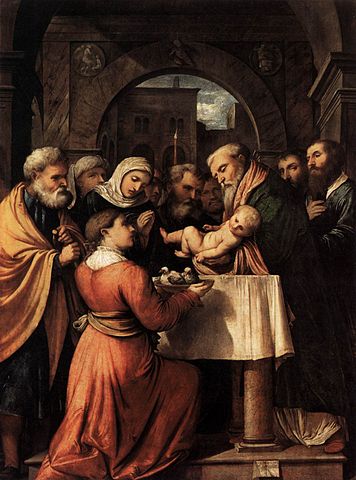 by Theresa Cavicchio
by Theresa Cavicchio“When the days were completed for their purification according to the law of Moses, [Mary and Joseph] took [Jesus] up to Jerusalem to present him to the Lord … “ (Lk 2:22)
Forty days after Christmas each year, we celebrate the feast commemorating the Presentation of the Infant Jesus. The Gospel of Luke outlines the account for us (2:22-39).
For a bit of a different perspective, the timing seems appropriate, following on the heels of the Year of Saint Joseph, to consider this special feast as seen through the eyes of one who lived it himself – the humble carpenter of Nazareth.
Joseph assists Mary as they set out for Jerusalem, their destination the great Temple, the bastion of faith for the Jewish people. The journey is long, fraught with dangers and inconveniences. Joseph’s awareness of his responsibilities as spouse of a new mother, and foster father of a most precious infant, is heightened each step of the way.
Joseph understands the ancient dictates of the Mosaic Law: the new mother of a male child must remain outside the Temple for forty days, after which ritual purification is to be performed for her; the newborn is to be dedicated to the Lord.
Their destination reached, Joseph presents the ritual offering of two small birds, the offering of the poor. In his humility, Joseph acknowledges his and Mary’s poverty and simply does the best he can. This would be the hallmark of his life -- past, present, and future.
His arrival for the Presentation inaugurates Jesus’ association with the Temple, to be repeated regularly on family pilgrimages for high holy days (Lk 2:41); His unexpected sojourn at age 12 (Lk 2:41 - 50); and, much later, the dramatic scene of the cleansing (Mk 11:15 - 18), among other occasions.
At the time of the Presentation, of course, Mary and Joseph are not gifted with foresight of any of these events. What they do experience is an encounter which surely takes them both by surprise.
Simeon, obviously long-schooled in contemplative prayer, and fully cognizant of the ancient prophecies, had received a profound revelation of the Holy Spirit: he would not die before he had seen the promised Messiah for whom the people of Israel had longed for many centuries.
In the person of the Infant Jesus, Simeon recognizes the fulfillment of this revelation. He approaches Mary and Joseph, takes the Infant Jesus in his arms, and prays aloud: “Now, Master, you may let your servant go in peace, according to your word, for my eyes have seen your salvation, which you prepared in sight of all the peoples, a light for revelation to the Gentiles, and glory for your people Israel” (Lk 2:29 - 32).
Simeon continues, his words both amazing and unsettling: “Behold, this child is destined for the fall and rise of many in Israel, and to be a sign that will be contradicted, and you yourself a sword will pierce so that the thoughts of many hearts may be revealed” (34 - 35).
In his encyclical Redemptorist Mater, Pope Saint John Paul II writes: “While [Simeon’s] announcement on the one hand confirms [Mary’s] faith in the accomplishment of the divine promises of salvation, on the other hand it also reveals to her that she will have to live her obedience of faith in suffering, at the side of the suffering Savior, and that her motherhood will be mysterious and sorrowful” (16).
As troubling as Simeon’s words may appear, Joseph is fully aware of three important facts: the true identity of the Child entrusted to his care; the unique role in salvation history of his wife; and the extraordinary workings of the Holy Spirit, already having been manifested in their lives.
As a result, Joseph would have approached Simeon’s words not in a state of disbelief, but rather the opposite. How else would this elderly man have recognized his Savior, singled Him out from all the other infants at the Temple that day, if not by reason of heavenly inspiration?
Simeon’s announcement only serves to confirm what Joseph already knows in the depths of his heart concerning Jesus’ divinity and His mission. It is the undertones of suffering to come for his family, however, so clearly couched in Simeon’s pronouncement, that would grip the loving, gentle heart of Joseph with anxious thoughts for their future.
How would this prophecy come to fulfillment for Jesus, the sign that would be contradicted; for Mary, in her piercing times of sorrow? If possible, Joseph would willingly accept that sword in her stead.
Blessed Bartolo Longo prays, “O most sensitive heart of St. Joseph, who, resembling the tender heart of Mary, felt the sorrows of the Most Holy Mother, tell me, what did you feel, hearing the terrible prophecy of Simeon? Yet with what generosity, with what silence and unalterable resignation did you accept from the hands of God even the sword of sorrow for our good!”
In the ineffable ways of God, it would fall to Joseph to accept the sufferings of his loved ones sensing that he would not be present to support and sustain them. This was an onerous weight he would have carried -- silently and patiently -- all through the years they shared as a family.
The Feast of the Presentation affords a character sketch of Joseph of Nazareth, its lines finely drawn: head of his family, man of poverty, faithful Jew, obedient to the Law, accepting of suffering. Two thousand years later, he models these qualities for us, encouraging us to bear all things with faith and trust that they are given by the hand of God for our eternal good.
© All Rights Reserved, Living His Life Abundantly®/Women of Grace® http://www.womenofgrace.com
